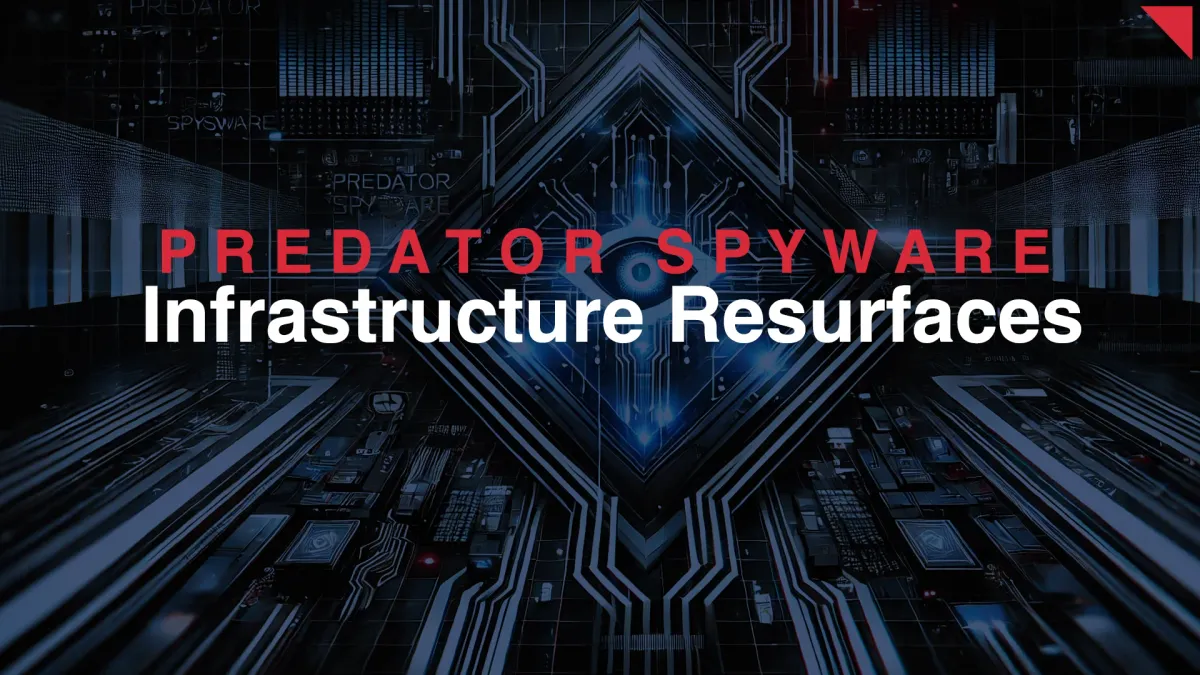Predator Spyware Infrastructure Resurfaces After US Sanctions
Insikt Group released a report revealing the return of Intellexa's Predator spyware infrastructure. Despite US government sanctions and a significant decline in activity following public exposure in 2023, Predator has resurfaced with modifications aimed at evading detection.

Introduction
On September 5, 2024, Insikt Group released a report revealing the return of Intellexa's Predator spyware infrastructure. Despite US government sanctions and a significant decline in activity following public exposure in 2023, Predator has resurfaced with modifications aimed at evading detection. The new infrastructure, detected in countries like the Democratic Republic of the Congo (DRC) and Angola, poses ongoing privacy and security risks, particularly to high-profile individuals such as politicians and executives.
Report Overview
Intellexa, a known supplier of the Predator spyware, initially faced sanctions and public scrutiny in 2023, leading to a marked reduction in its operations. However, recent research by Insikt Group indicates that Predator is back in action, with new infrastructure designed to make tracking and attribution more difficult. The spyware, typically used by governments and high-value operators, infiltrates devices to gain access to sensitive data, including messages, contacts, and even control over cameras and microphones.
In this new wave of activity, Predator's infrastructure has become more complex. The spyware has adopted a multi-tiered delivery system that anonymizes user operations, making it more difficult to trace back to specific operators. This layer of obfuscation further complicates efforts by cybersecurity defenders to pinpoint Predator's reach.
Predator's attack methods remain consistent with earlier iterations, relying on both one-click and zero-click vulnerabilities in browser software. While there are no confirmed reports of fully remote zero-click attacks, the spyware remains a potent tool in the hands of those looking to exploit high-profile targets. It is primarily deployed via spear-phishing campaigns and other forms of social engineering.
Insights and Analysis
The resurgence of Predator presents serious concerns for governments, corporations, and individuals in sensitive roles. The spyware’s infrastructure has been identified in politically sensitive regions such as the DRC and Angola, suggesting it is still being used for surveillance purposes. Those at the highest risk of Predator attacks include politicians, executives, journalists, and activists.
The consequences of such spyware are far-reaching. Not only can Predator gain access to personal and professional communications, but it also presents a significant threat to the safety of individuals targeted by such malicious software. The use of spyware like Predator in the context of political repression and government surveillance raises urgent questions about privacy, security, and international law.
Insikt Group’s findings suggest that Predator’s operators have successfully adapted to the changing cybersecurity landscape. While the sanctions and public exposure of Intellexa’s activities dealt a significant blow to the spyware’s operations, the reemergence of its infrastructure indicates that spyware developers continue to find ways around these challenges. The cost and complexity of Predator make it a tool reserved for strategic, high-value targets.
Predator’s return signals a continued escalation in the arms race between spyware developers and cybersecurity defenders. While the infrastructure has evolved, the key to protection remains in the hands of individuals and organizations. Insikt Group advises the following preventative measures to mitigate the risk of Predator infiltration:
- Regular software updates to close vulnerabilities exploited by spyware.
- Periodic device reboots to disrupt spyware operations.
- Activation of lockdown mode on devices to prevent unauthorized access.
- Deployment of Mobile Device Management (MDM) systems to enforce security protocols.
As the spyware market continues to grow, regulatory efforts must keep pace to curb the use of these tools. With ongoing research and public reporting, global actions aimed at restricting the use of spyware like Predator will be crucial to reducing its impact.
Indicators of Compromise (IOCs)
| Indicator | Type | Description |
|---|---|---|
| happytotstoys[.]com | Domain | Malicious domain associated with Predator infrastructure. |
| holidaypriceguide[.]com | Domain | Another domain linked to Predator spyware operations. |
| lesautreseux[.]com | Domain | Domain used for Predator spyware activity. |
| masoloyakati[.]com | Domain | Infrastructure domain tied to Predator's resurgence. |
| noisyball[.]com | Domain | Part of Predator's network to evade detection. |
| nyirangongovrai[.]com | Domain | Domain used to obscure Predator's activities. |
| toysfourtots[.]com | Domain | Another domain associated with Predator spyware. |
| yokananu[.]net | Domain | Used in Predator's multi-tiered infrastructure. |
| 169.239.129[.]76 | IP Address | IP address related to Predator's infrastructure. |
| 185.123.102[.]40 | IP Address | IP address associated with Predator operations. |
| 185.235.137[.]6 | IP Address | Known IP used in Predator spyware activity. |
| 185.243.113[.]169 | IP Address | Associated IP address for Predator network. |
| 193.29.56[.]252 | IP Address | Infrastructure IP linked to Predator spyware. |
| 193.29.59[.]164 | IP Address | Part of the IP range used by Predator operators. |
| 45.86.163[.]178 | IP Address | Malicious IP address associated with Predator spyware. |
| 98.142.253[.]18 | IP Address | Used in Predator's infrastructure to evade detection. |
MITRE ATT&CK Techniques
| Tactic | Technique | ID | Description |
|---|---|---|---|
| Resource Development | Acquire Infrastructure: Domains | T1583.001 | Domains registered or acquired by Predator operators for spyware delivery. |
| Resource Development | Acquire Infrastructure: Virtual Private Server | T1583.003 | Virtual Private Servers used by Predator operators to evade detection. |
| Resource Development | Acquire Infrastructure: Server | T1583.004 | Physical or cloud servers obtained for the operation of Predator infrastructure. |
| Initial Access | Spearphishing Link | T1566.002 | Spearphishing attacks using links to deliver Predator spyware. |
References





Comments ()